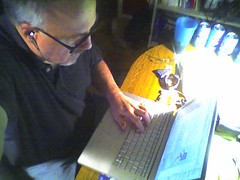I’m sitting here with only a few minutes left before I have to pack for my flight to Chicago and the IL-TCE (Illinois – Technology Conference for Educators). I’ve been finishing up my online handouts, and also put together a blog and image aggregator for the conference on my web site. You can see it at:
http://davidwarlick.com/drupal//?q=node/51
The main purpose of this blog entry is the presentation that I did a couple of days ago for MEGA on Web 2.0. By all indications the session was a wild success. I must have been really “on” that day, because the room was thick with excitement. I thought that one woman was going to go into convulsions and start speaking in tongues. Well that’s a bit of an exageration, though she had to be led from the room babbling “RSS is the new WWW, RSS is the new WWW” 😉 I’m just fooling.
The session was a challenge, in that I had only 45 minutes to do the presentation. So I decided to condense one of the bulleted lists on one of my slides (the only slide with a bulleted list). A few weeks ago a posted a list of Web 2.0 Bottom Line Concepts. There were five of them, but, for the sake of Tuesday’s presentation, I condensed them to three, and I’m pretty happy with this list.
Now it is important to note that Web 2.0 is something different to each user. We all create our own metaphors to label our experience and to describe it to other people. So this is my list. If you thing other concepts should be included, then please comment.
- Content is Conversation
- Content is organizing itself
- People are connect to each other through their content
Millions of people are talking now, and they are talking in such a way (blogs, wikis, and podcasting) that the world is potentially their audience. This is important, I believe, because in a time of rapid change, the answer to brand new questions may not come from someone who got their PHD ten years ago. It may just come from something, that somebody said, yesterday.
Well this is a rather melodramatic statement, meant to start a conversation about how the way that information flows is largely resulting from the behavior of its readers. Aggregators, mashups, blog linkings, and other more esoteric techniques are causing us to reshape the information environment on a global and on a personal level.
This one has had a personal impact on me, as I have made new friends through the comments and blog-passing of people who react to my ideas. Far more important is the fact that through these exchanges, I have learned. My ideas have been challenged and they have grown, as have I.
So, please comment or write about this. Lets grow this thing, or perhaps even further condense it.
2¢ Worth!


“Content is organizing itself”
I think it really important to speak about tags here — or at least this whole “folksonomy” concept of individualzed organization. For tags give each of us an ability to organize the same content in myriad ways that matter to us (and may even my nonsensical to most). I’m actually not sure if that is the same thing as “organizing itself” — more that there is now a real ability to organize/re-organize individually. i don’t even know if I’m making sense. This is way to jargony (as if “tags” and “folksonomy” weren’t bad enough) — but it’s almost as if content were disaggregating itself, more specifically than organizing itself. Isn’t it?
Your main three points:
Content is conversation
Content is organizaing itself
People are connecting to each other through their content
are right on target and universally describe what is taking place in almost every market segment
Have fun in IL
Jay
http://www.jaybryant.com
David,
I think there’s more to the story and particularly on the technical side where composition of smaller objects and functions are likely with eLearning 2.0.
I’ve posted a few times on different aspects (http://elearningtech.blogspot.comm) and would say that we pretty much are aligned except that I include this other aspect. I’d be curious to get your take on some of my posts around eLearning 2.0.
Tony
great site…very good